



House Radiators UK - FAQS
How To Replace Radiators In Your House?
How to replace house radiators in your home is a not as complex as you may think. Whether you want to hire someone to assist you, or you’re more of a DIY advocate, the process is very simple. We at Stelrad are here to guide you so that you have your house radiator up and running in your UK home in no time at all.
- Mark the centre line of your house radiator on the wall. This will indicate the centre point of where it will be placed.
- Mark the bottom line of your house radiator, showing how high you would like the bottom of the radiator to be from the floor.
- Check the distance between the bracket and the back of your house radiator.
- Mark this measurement on the wall.
- Make your final measurement – the distance between the top bracket and the bottom bracket.
- Drill your house radiator to the wall.
- Sit back, relax, and enjoy the heat!
Where To Place Radiators In A House?
Where to place radiators in your house depends on the room, the style of radiator and whether it will disrupt your feng-shui – although the latter is somewhat more of a preference point, and it won’t affect heat dispersion.
Kitchens, and other open-plan rooms are often the coldest in your home, but whichever room you are considering to buy a house radiator for in your UK home, the placement of your house radiator is the most important factor to consider.
The efficiency of your house radiator will be at its maximum if placed in the coldest part of the room. Generally, this is under a window, as cold air creates better heat conductivity through convection.
For homes with double glazed windows, your home will usually be warmer, but regardless of this, placing your house radiator under the window will prove to be the best decision. Heat loves to escape, and the window is usually the most accessible route.
See our radiator BTU heat calculator to figure out which UK house radiator is most suitable for you.
How A House Radiator Works?
The way in which a house radiator works is simple process – so simple, that you won’t have to worry about the ins and outs of it most of the time.
A central heating house radiator has hot water flowing through it. As the hot water flows through, it heats up either the columns or body of the house radiator, creating convection and heating the surrounding air of your home.
If you have any more questions regarding Column Radiators and for all radiator FAQs, view our advice hub.




